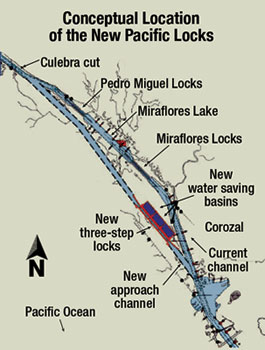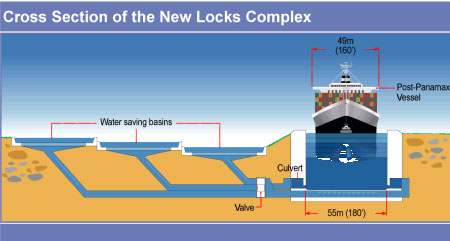
|

|
The people of Panama have given the go-ahead to the most extensive overhaul of one of the modern world’s greatest engineering achievements.
On Sunday, Oct. 22, almost 80 percent of voters approved a referendum that will allow a $5.25-billion expansion of the Panama Canal to proceed. The project consists of building a new lane of traffic along the existing canal through the construction of a new set of locks.
In an interview the day after the referendum, Alberto Alemán Zubieta, the administrator of the Panama Canal Authority (or ACP), the autonomous government agency that maintains the waterway, said the project was an opportunity for all of Panama.
“Now we have a very important responsibility not only the for the ACP as an institution but for the Panamanian society as a whole,” he said. “We must do this project in a proper way to show the world we can tackle a project of this magnitude and do it well.”
According to the ACP, the 50-mile-long waterway is currently operating at almost 93 percent capacity. Last year, the more than 14,000 vessels that used the canal brought in an estimated $1.2 billion in tolls.
Furthermore, the widening is necessary because the existing locks are of insufficient size to permit the passage of post-Panamax ships that are up to 180 feet across and 1,400 feet long.
The initial focus of the construction effort will be preparing the environmental impact report, final design plans and contractor selection, ACP officials said. Although this phase could last as long as three years for the locks component of the project, work on other portions could begin sooner.
Dry excavation and the dredging of channels will begin immediately, ACP officials said. In addition, a recent $1 billion modernization and maintenance program included substantial work that will augment the planned upgrades – notably deepening and widening of the existing channels to guarantee the transit of post-Panamax vessels.
|
The first major construction aspect of the project itself, excavation of a new five-mile navigation channel for southernmost locks, is slated to begin at the end of next year. These works will be located near the former third locks excavation site project initiated by the US in 1939, and suspended in 1942 due to World War II.
Although the ACP plans to pay for the work through a system of graduated toll increases it will now begin seeking $2.3 billion in loans or bonds to finance the project – a task Alemán estimates will be completed by the end of next year. The expansion is expected to raise the annual income from tolls to more than $6 billion.
The Panama Canal currently utilizes three sets of two-lane locks, each of which is 33.53 meters wide by 304.8 meters long. These locks lift vessels 85 feet above sea level to access Gatun Lake.
The project will create a new lane of traffic along the canal through the construction of two new sets of locks. The new lock chambers will be 427 meters, long by 55 meters wide, and 18.3 meters deep.
Additionally, Gatun Lake water level will be raised about 45 centimeters to reach its maximum operational level.
The new locks will feature water-saving basins designed to reuse as much as 60 percent of the water during each transit. The individual basins will be approximately 70 meters wide by 5.50 meters deep. Each lock chamber will utilize three basins and there will be a total of 18 basins for the entire project.
 Photo:ACP
|
This technology eliminates the need for constructing dams, flooding and displacing communities along the Canal’s Watershed, Alemán said.
The locks are slated to cost $1.11 billion for the Atlantic side and $1.03 billion for the Pacific side with $590 million contingencies during construction. The Atlantic side water reutilization basins are expected to cost $270 million and the Pacific side basins $210 million with $140 million in contingencies.
The improvements to the navigation channels and water supply improvements are expected to take up the bulk of he rest of the costs.
Both the Atlantic and Pacific entrance channels will be widened and deepened. One of the new three-step lock complexes will be built near the existing Gatun locks on the Atlantic side and a complex on the Pacific side will be located near the existing Miraflores Locks.
Since all construction sites are outside of existing channels and operating areas there will not be any disruption in current canal traffic, ACP officials said. The schedule calls for the expansion to be completed in 2014.
 Related Links:
Related Links: 

Post a comment to this article
Report Abusive Comment